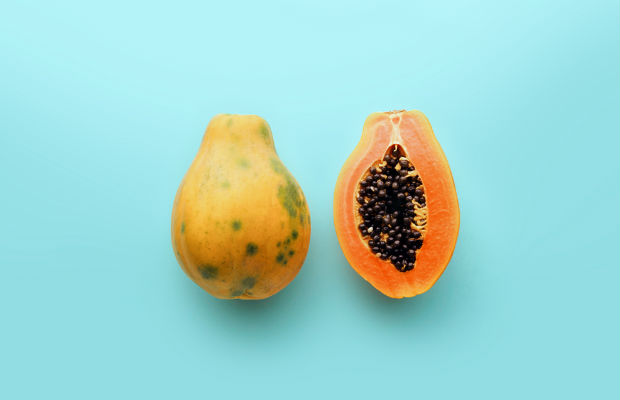You might have been led to believe that all tropical fruits are seasonal – but papayas are in fact available all through the year, from January to December. The shape of the fruit is influenced by whether it is from a female tree (round-shaped fruit) or a hermaphrodite (pear- or oblong-shaped fruit). The papaya you buy from local South African supermarkets is from the Carica papaya plant and through conventional breeding, the fruit’s sweet taste and flavour have been improved.
Flavour and uses in cooking
You might be familiar with the popular papaya breakfast dish of chopped up fruit with a dollop of thick Greek yoghurt and a drizzle of honey and toasted almonds. It’s deliciously sweet and quite irresistible, but there are countless other ways of utilising papaya in cooking. You can lightly grill it, chop it up for a zesty salsa and even use papaya purée to tenderise meat and poultry – as it contains an enzyme that denatures the long strands of proteins that make up tough meat fibres. The fruit itself has a sweet, tropical flavour that makes it great in Thai and Asian cuisine – for both sweet and savoury dishes.
Why it’s healthy
In addition to papaya’s versatility, it has also often been lauded as a real health hero. In fact, Health24 says the fruit has been shown to have potent antioxidant properties that are great for the treatment of burns, vitamin A deficiency, skin conditions and a host of other ailments. Read more about the health benefits of papaya here.
How do you know if it’s ripe?
When you’re shopping for papayas, look for ones that have smooth skin and feel heavy for their size. The texture should be firm, not squishy. If you’re going to be using the fruit right away, look for one that’s reached its peak ripeness – otherwise buy ones that can ripen at home. The main thing to remember is that you want to eat it at its optimum flavour.
Storing it at home
To speed up the ripening process, leave papayas on a countertop at room temperature, otherwise store in the fridge. Always keep the skin on until you’re ready to use it. Papaya can also be frozen – peel it beforehand and store in an airtight container or freezer bag.
Tips for preparing it
– Always remove the seeds when presenting the papaya or offering it to someone to eat.
– Fresh papaya contains a specific enzyme that destroys the protein molecules in gelatine, so if you’re making a dessert or mousse that calls for gelatine, always poach the papaya beforehand. Canned fruit has already been heated, however, so these are fine to use in gelatin desserts as is.
Storing it at home
To speed up the ripening process, leave papaya on a countertop at room temperature, otherwise store in the fridge. Always keep the skin on until you’re ready to use it. Papaya can also be frozen – peel it beforehand and store in an airtight container or freezer bag.
Tips for preparing it
– Always remove the seeds when presenting the papaya or offering it to someone to eat.
– Fresh papaya – like kiwi fruit, honeydew melon and pineapple – contains a specific enzyme that destroys the protein molecules in gelatine, so if you’re making a dessert or mousse that calls for gelatine, always poach the papaya beforehand. Canned fruit has already been heated, however, so these are fine to use in gelatin desserts as is.
To celebrate the versatility of papaya, Neofresh is looking for great papaya recipe recipes from amateur home-cooks in South Africa. There are 5 categories to enter and each category winner will receive a cash prize of R10 000. Click here to enter!

